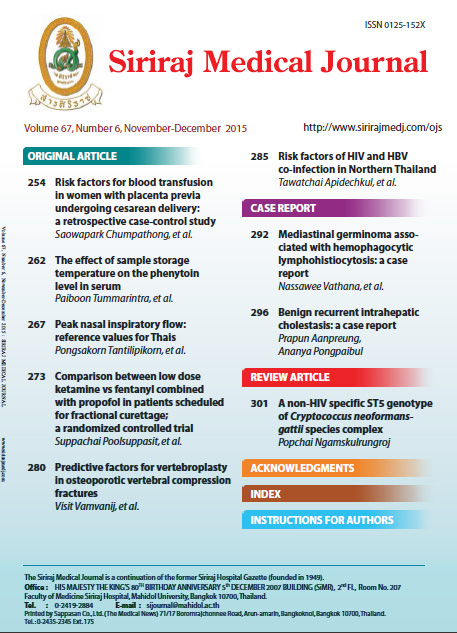The Effect of Sample Storage Temperature on the Phenytoin Level in Serum
Keywords:
Phenytoin, stability, storageAbstract
Objective: To study the effect of temperature on phenytoin concentration in serum and to determine the sample were kept at 2-8°C and 35°C.
Methods: Serum samples of patients, who had been treated with phenytoin. had their phenytoin level determined on the first day. The sample was stored for seven days and analyzed on days three, five and seven of the study and divided into three storage concentrations from 2.5-10, 10.1-20 and 20.1-30 µg/ml compared using 50 samples per group.
Results: Phenytoin level was found to have increased over time to three days at a temperature of 35°C and five days at 2-8°C. It increased in the level of statistical significance at p<0.05. This study’s data were all well correlated at r2 = 0.9981-0.9999.
Discussion: Collected samples for analysis of phenytoin level must be stored at 2-8°C and stored for at least five days, to prevent degradation of protein which cannot bind to the drug. The phenytoin levels in serum increased to make the diagnosis of dosage mistakes.
Keywords: Phenytoin, stability, storage
Downloads
Published
How to Cite
Issue
Section
License
Copyright (c) 2015 Siriraj Medical Journal

This work is licensed under a Creative Commons Attribution-NonCommercial-NoDerivatives 4.0 International License.
Authors who publish with this journal agree to the following conditions:
Copyright Transfer
In submitting a manuscript, the authors acknowledge that the work will become the copyrighted property of Siriraj Medical Journal upon publication.
License
Articles are licensed under a Creative Commons Attribution-NonCommercial-NoDerivatives 4.0 International License (CC BY-NC-ND 4.0). This license allows for the sharing of the work for non-commercial purposes with proper attribution to the authors and the journal. However, it does not permit modifications or the creation of derivative works.
Sharing and Access
Authors are encouraged to share their article on their personal or institutional websites and through other non-commercial platforms. Doing so can increase readership and citations.










